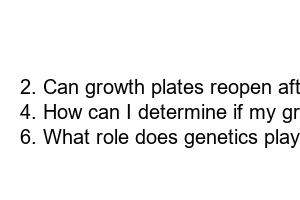성장판 닫히는 시기
**Understanding When Growth Plates Close**
Have you ever wondered about the *growth plates* in our bones and when they close? This important process plays a crucial role in our development and overall health. In this blog post, we will delve into the details of when growth plates close and what it means for our bodies.
**What are Growth Plates?**
*Growth plates* are areas of cartilage at the ends of our long bones that are responsible for bone growth. They are crucial during childhood and adolescence, as they determine the final length and shape of our bones.
**When Do Growth Plates Close?**
By the time we reach our late teens or early twenties, most *growth plates* have closed. This marks the end of our potential for vertical growth.
**Why Do Growth Plates Close?**
The closure of *growth plates* is a natural part of the bone development process. Once they close, bones can no longer grow in length, allowing the body to focus on other aspects of growth and development.
**What Happens When Growth Plates Close?**
Once *growth plates* close, bones stop growing in length. This means that individuals will reach their final height and no longer experience vertical growth.
**Can Growth Plates Close Prematurely?**
In some cases, *growth plates* can close prematurely due to injury or medical conditions. This can affect a person’s final height and may require medical intervention.
**How Can I Support Healthy Growth Plate Closure?**
To support the natural closure of *growth plates*, it is important to maintain a healthy diet rich in essential nutrients and to engage in regular physical activity. Adequate rest and proper posture can also play a role in bone health.
**Summary**
In conclusion, understanding when *growth plates* close is important for our overall health and development. By knowing how and why this process occurs, we can better support our bodies as they reach their full potential.
**FAQs**
1. At what age do growth plates typically close?
2. Can growth plates reopen after closing?
3. What factors can affect the closure of growth plates?
4. How can I determine if my growth plates have closed?
5. Are there any medical conditions that can delay the closure of growth plates?
6. What role does genetics play in growth plate closure?

